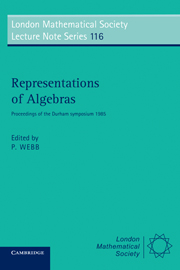Book contents
- Frontmatter
- Contents
- Introduction
- Representation theory of finite-dimensional algebras
- A survey of existence theorems for almost split sequences
- Representations of posets and tame matrix problems
- Geometry of representations of quivers
- Cohen-Macaulay modules on hypersurface singularities
- Almost split sequences and algebraic geometry
- Representation rings of finite groups
Introduction
Published online by Cambridge University Press: 01 March 2011
- Frontmatter
- Contents
- Introduction
- Representation theory of finite-dimensional algebras
- A survey of existence theorems for almost split sequences
- Representations of posets and tame matrix problems
- Geometry of representations of quivers
- Cohen-Macaulay modules on hypersurface singularities
- Almost split sequences and algebraic geometry
- Representation rings of finite groups
Summary
This volume presents the core of expository lectures given at the 1985 Durham symposium on representations of algebras. Between them they survey a good part of the cutting edge of research in the area of diagrammatic representation theory, and also with the article by Benson, some recent modular representation theory of groups. The lectures were given to a mixed audience of specialists in various parts of algebra, and it was not possible to assume that everyone was up to the minute with the jargon. An attempt has been made to write down the lectures in a similar spirit in the hope that their readership will be as wide as possible.
It is not easy to get into the area of ‘quiver’ representation theory from the outside because the area has been expanding so rapidly, and there is no single text where all the fundamentals are developed. Unfortunately the beginner has to read around a bit, and to help with this and set the scene for the articles in this book I propose to give a brief sketch of the way the subject has gone, indicating where accounts of the theory may be found. Useful general references are Gabriel (1980), and Ringel (1984), Chapter 2.
The subject began in the late 1960's with the work of Gabriel, Auslander and several Soviet mathematicians, including Nazarova and Roiter. Gabriel considered representations of quivers because these simultaneously deal with various types of matrix classification and also representations of algebras.
- Type
- Chapter
- Information
- Representations of AlgebrasProceedings of the Durham Symposium 1985, pp. 1 - 6Publisher: Cambridge University PressPrint publication year: 1986

